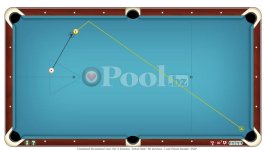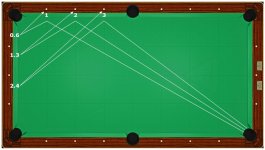The way you hit the ball, manipulates it's path off the rail, so that it curves and approaches the pocket from a slightly different angle.
So imagine shooting a cueball directly into the side pocket from frozen to the bottom rail, vs shooting it into the same side pocket from the exact middle of the table.
One of those 2 shots is going to be easier because you have a much bigger pocket target to aim at. Right?
I'm pretty sure that is what J.B. is talking about.
Obviously, we are talking about subtle differences in the size of the "bigger" pocket angle vs the normal angle, but to bankers, that's a HUGE difference.
If you are wondering about the curve i am talking about, stand at the head of the table, and put the cueball away from the top rail one diamond, and one diamond away from the side rail on either side.
Then just start shooting the cueball by itself off the side rail you are closest to, trying to make the cueball 1 rail into the opposite corner pocket that is down table.
Now shoot this same cueball shot with draw at different speeds at the same exact angle each time, and you will see an exaggerated example of the principle i am talking about and how it can be manipulated when you watch the cueball curve after hitting the first rail, and traveling different paths based on your speed and draw.
Now imagine you can curve an object ball kinda like that.
The curve you're talking about is true. You can really see the ball bend on its way toward the pocket. JB first showed me that by standing in the rebound path of the ball while he shot it. Blew my mind. Better yet, doing this imparts beneficial spin on the object ball which helps it spin into the pocket should you brush the rail on the way in. Really neat stuff.


